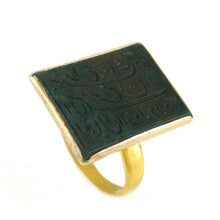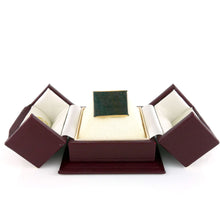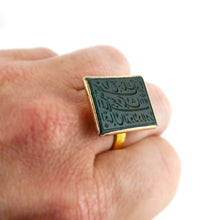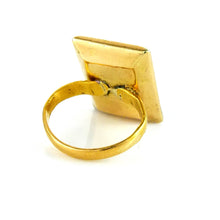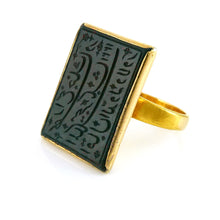Mughal India - An Imperial Presentation Seal Ring to a British Officer, 1806
Adding product to your cart
Stone: 24.5mm x 18.5mm
Bloodstone mounted of a plain gold shank. Of rectangular form, the panel inscribed ‘Iqbàl al-Dowla, Dilàwar al-Mullé, Major Bagshaw(e), Ràsileh Jang Bahàdur 1221 (A.H.)’.
The present seal is an honorific gift from the Mughal Emperor Shah Alam II (1728-1806). It bestows honorary Muslim titles on a British officer, Major David Bagshaw, for his part in the defence of the imperial seat, the Red Fort, Delhi against the forces of Mahratta chieftain Jaswant Rao Holkar in October 1804. The seal reflects reciprocation of the efforts by East India Company officers to forge a respectful relationship with Shah Alam II, and to follow the protocols of the Mughal court. The custom of honouring the British in this way was well established and reached back to the time of Robert Clive. However by 1804 the power of Mughal Emperor was seriously depleted, the Mahrattas having wrested control over much of India from the Mughals during the previous century. So much so that a Persian saying - Sultanat-e-Shah Alam, Az Dilli ta Palam - maintained 'The empire of Shah Alam is from Delhi to Palam’, Palam being a suburb of Delhi.
Read more
Nevertheless the blind and elderly Shah Alam remained the font of honours on the sub-continent. He commanded respect as a dignified member of the House of Timur. The Nawabs (rulers of princely states) and Subedars (provincial governors) still sought his sanction on accession and valued the titles he bestowed upon them. Moreover coins were struck in his name and Friday sermons read in his honour, despite being used by successive competing powers that included invading Afghans, the Maratha Confederacy, Mughal ursurpers and the British East India Company.
In 1803 disagreement between the five major chiefs of the Mahratta Confederacy, one of whom had conceded territory to the British, led to internal fighting and the outbreak of the Second Anglo-Mahratta War (1803-05). In September the future Duke of Wellington secured the Deccan with his famous victory over Scindia at Assaye. Meanwhile Bagshaw was detached from his regiment, the 17th Native Infantry at Cawnpore, and placed in command of four companies that had been ordered to join General Lord Lake’s army. Lake was tasked with securing the Delhi Doab and gaining custody of Emperor Shah Alam II, lest French officers in Mahratta service used him to further French ambition in India.
On 1 September Lake arrived with the 76th Foot and thirteen native battalions before Ally Guhr (Aligarh) Fort. The stronghold was considered one of the most impregnable in India. The garrison had been trained by the French mercenary Pierre Cuillier-Perron (1754-1834). Its defences included French artillery, tigers and lions from Scindia’s menagerie and a network ditches filled with sword blades and poisoned chevaux-de-frise. It was taken by storm on 4 September with Captain Bagshaw numbering among the 254 British and Bengali casualties, in what the Duke of Wellington declared was ‘one of the most extraordinary feats of the British conquest of Northern India’.
Bagshaw continued with Lake’s 4,500-strong army to Delhi where on 14 September Scindia’s forces of 17,000 under the command of General Louis Bourquin and Sardar Ravsaheb Wable were entrenched in a strong position at Pataparganj, right across the Yamuna River from Humayun's Tomb. Lake was repulsed, but drew the French officered Mahratta battalions from their lines, whereupon Lake counter attacked, and drove them at bayonet point into the river. Mahratta casualties were 3,000 for a loss of under 500 British and Bengali troops. The city of Delhi fell three days later, ending the Mahratta rule over the Mughals and bringing Shah Alam under British protection.
When Lake moved on to Agra and to fight the decisive battle with Scindia at Laswaree, Bagshaw and his men were left at Delhi as part of the garrison under Sir David Ochterlony to bolster Alam Shah’s authority. In October 1804 the Mahratta leader Jaswant Rao Holkar who had achieved successes against the army of General Monson tried to further his prestige by seizing control of the Red Fort and the Mughal Emperor within. Holkar attacked with with 60,000 cavalry and 15,000 infantry, pounding the walls and battering the Ajmeri, Kashmiri and Lahori Gates for a week - once again Bagshaw was in the thick of the fighting. On 18 October 1804 Holkar abandoned the siege after a relief force arrived under Lake.
It was against this background that Bagshaw was gifted the present seal by the Emperor in the Mughal calendar year 1221 - March 1806 - March 1807 in the Gregorian calendar. The present ring was appraised in 2002 by James Allen, Keeper of Asian Art at the Ashmolean Museum, Oxford. Professor Allen noted ‘the seal follows the formal order of Mughal titles, the British being a kind of honorary Muslims!’

Shah Alam II (1728-1806) nominally ruled the Mughal empire from December 1759. He fought the British at the Battle of Buxar in 1764 and later corresponded with Tipu Sultan during the Mysorean wars against British expansion. In 1788 while under the protection of the Mahratta general Mahadaji Shinde, Shah Alam was blinded by Ghulam Qadir with an Afghani knife. Three servants and two water-carriers who tried to help the bleeding Emperor were beheaded. After ten weeks, during which Ghulam Qadir stripped the princesses of the royal family and forced them to dance naked before him (after which they jumped into Yamuna to drown), the honour of the royal family and prestige of the Mughal Empire reached its lowest ebb. Mahadaji Shinde intervened and killed Ghulam Qadir, taking possession of Delhi restored Shah Alam II to the throne and acted as his protector. Shah Alam also penned a famous book Ajaib-ul-Qasas which is considered one of the earliest and prominent books of prose in Urdu. He died of natural causes on 19 November 1806. His grave lies next to the dargah of the 13th century Sufi saint, Qutbuddin Bakhtiar Kaki at Mehrauli, Delhi in a marble enclosure.
Robert Morris Bagshaw (1769-1807) joined the East India Company’s 1st European Regiment as an eleven year-old Cadet at Fort William (Kolkata) in 1780. At thirteen he was promoted to the rank of Ensign and as a seventeen year old Lieutenant he was placed on half-pay owing to a reduction of the Company’s forces in 1786. By 1794 he was serving in the 11th Battalion of Sepoys when he was seconded to the 2nd Sepoys for duties on the Burmese frontier. In 1795 he joined the 11th Sepoys on Prince of Wales’s Island (Penang) where he was adjutant to the garrison before being appointed to the Marine Battalion. In 1798 he was posted to 2nd Battalion, 17th Native Infantry with which he spent the remainder of his career. In early 1803 he commanded a detachment of his regiment in the Mud War, fought against recalcitrant zemindars holding mud forts in the Yamuna Doab, and was engaged at Kachauria and Tattia. After the repulse of Holkar from Delhi in October 1804, he was with the 2/17th N.I. beyond the Yamuna in Lake’s main army, and took part in the pursuit of Holkar across the Sutlej and deep into the Punjab. On the final submission of Holkar he returned with the army and was posted with his battalion to Panipat and then Karnal where he died on 26 February 1807. He is interred in the largest of four tombs in plot 28 of the European cemetery in Karnal, near Delhi. He was promoted Major on 14 November 1805.









